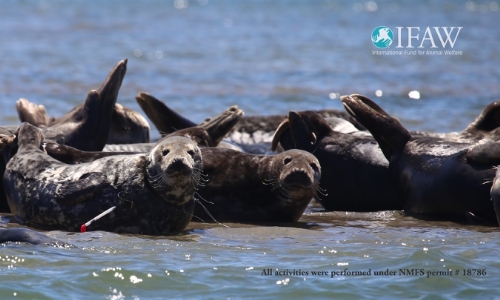YARMOUTH PORT, Mass., 2016: The first successful seal rescue using remote sedation on the East Coast of the U.S a week ago. Biologists and veterinarians from the International Fund for Animal Welfare (IFAW) and The Marine Mammal Center (the Center).They employed techniques that the Center and other agencies have developed on the West Coast to assist entangled California sea lions. The method incorporates darting an entangled seal or sea lion to allow it to be captured, examined by a veterinarian, disentangled, medically treated, and released.

The bi-coastal experts joined together to address entanglements, one of the greatest human-caused threats to seals and sea lions. Entanglements, often caused by fishing gear or human sources of marine debris, cause life-threatening constrictions around the necks and bodies of these marine mammals. As seal populations re-establish in New England; there is risk of an increased number of seals becoming entangled.
“In 2001, reports of seal entanglements started to become common,” said Kristen Patchett, Stranding Coordinator for IFAW. “Since then, we have been working to develop a safe and effective method of capturing and disentangling seals. While we’ve had some successes, more reliable techniques will allow us to save more entangled seals.”
Working in cooperation with the local fishing community and seal watch operators, the IFAW team has made several attempts to capture and disentangle seals with life threatening entanglements, but without reliably repeatable success.
“Our innovative darting technique increases the effectiveness of sedation, tracking, and rescue of seals and sea lions entangled by fishing gear,” said Dr. Shawn Johnson, Director of Veterinary Science at The Marine Mammal Center. “The success of this acoustic tracking dart will have a significant impact on future rescue operations.”
The new method of using remote sedation shows the most promise. It involves darting a seal from a distance of approximately 60 feet and then tracking the seal as it flushes into the water. In order to track the seal, the Center has devised a novel method of incorporating a small acoustic transmitter in the dart to allow responders to track the seal while waiting for the sedative drugs to take effect.
In addition to tracking, another major challenge is that properly sedating seals can be difficult. Field conditions make it even more risky. To ensure best practices, the team has been consulting with additional experts to determine the safest, most effective drugs and dosages for these captures. Last week’s successful sedation, capture, disentanglement, and release is a significant step forward in responding to entangled seals locally, but also has national and international implications in addressing entanglements. The information gathered on drug efficacy, capture tools and techniques may even be used in the future for seals from threatened or endangered populations in other parts of the world.
Prior to release, the disentangled gray seal was affixed with a small, temporary satellite tag that will allow IFAW staff the opportunity to track the seal over the coming months to monitor its recovery and document the healing of the deep lacerations caused by the entanglement.
This work was made possible by IFAW, the Center and a federal John H. Prescott grant issued to IFAW. The team was joined by responders from the Center for Coastal Studies, National Marine Life Center and National Oceanic and Atmospheric Administration.
About International Fund for Animal Welfare
Founded in 1969, IFAW rescues and protects animals around the world. With projects in more than 40 countries, IFAW rescues individual animals, works to prevent cruelty to animals, and advocates for the protection of wildlife and habitats. For more information, visit www.ifaw.org. Follow us on Facebook/IFAW and Twitter @action4ifaw
About The Marine Mammal Center
The Marine Mammal Center is a nonprofit veterinary hospital, research and educational center dedicated to the rescue and rehabilitation of sick and injured marine mammals and to the study of their health. Since 1975, the Center has been headquartered in the Marin Headlands, Sausalito, Calif., within the Golden Gate National Parks and has rescued and treated more than 20,000 marine mammals. In 2014, the Center opened Ke Kai Ola, a hospital for the rehabilitation of the critically endangered Hawaiian monk seal, in Kailua-Kona, Hawaii. For more information, please visit www.marinemammalcenter.org. Follow on Facebook/themarinemammalcenter and Twitter @TMMC

Do you buy old cypress lumber